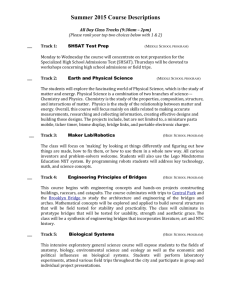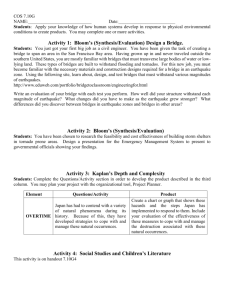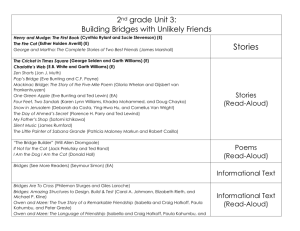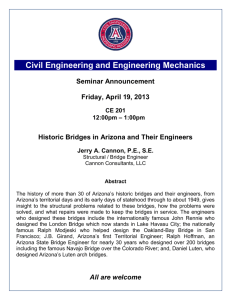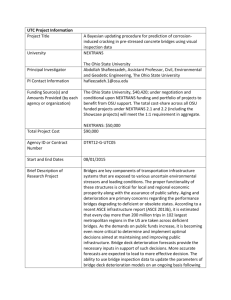Click here to view a copy of my Writing Assignment 3
advertisement
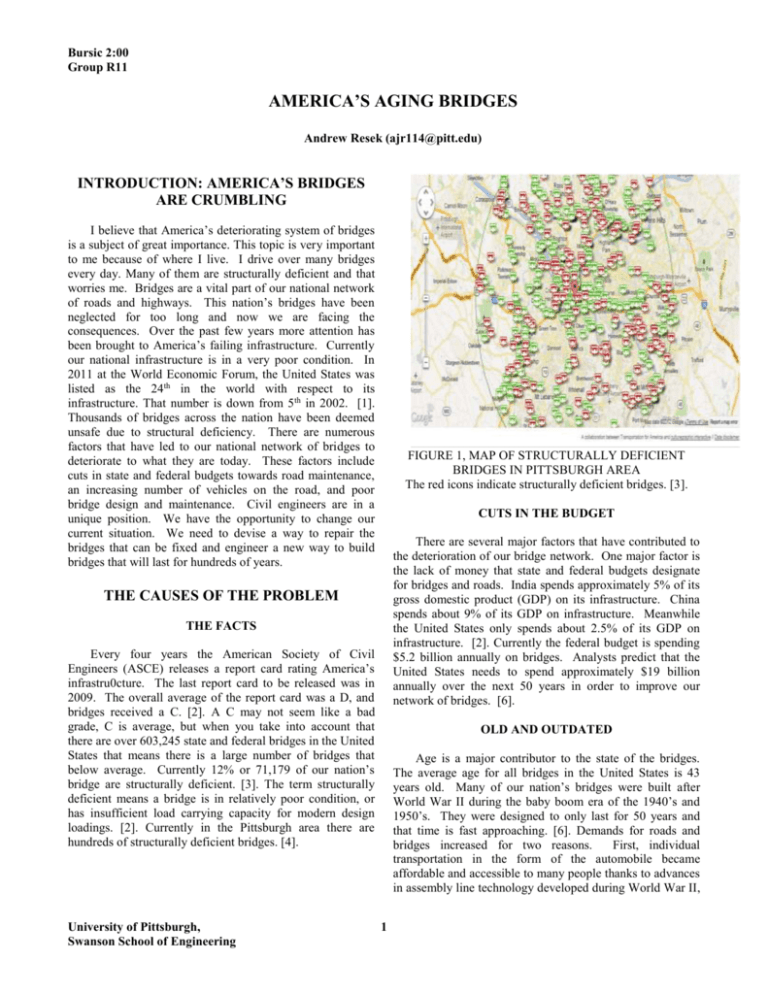
Bursic 2:00 Group R11 AMERICA’S AGING BRIDGES Andrew Resek (ajr114@pitt.edu) INTRODUCTION: AMERICA’S BRIDGES ARE CRUMBLING I believe that America’s deteriorating system of bridges is a subject of great importance. This topic is very important to me because of where I live. I drive over many bridges every day. Many of them are structurally deficient and that worries me. Bridges are a vital part of our national network of roads and highways. This nation’s bridges have been neglected for too long and now we are facing the consequences. Over the past few years more attention has been brought to America’s failing infrastructure. Currently our national infrastructure is in a very poor condition. In 2011 at the World Economic Forum, the United States was listed as the 24th in the world with respect to its infrastructure. That number is down from 5 th in 2002. [1]. Thousands of bridges across the nation have been deemed unsafe due to structural deficiency. There are numerous factors that have led to our national network of bridges to deteriorate to what they are today. These factors include cuts in state and federal budgets towards road maintenance, an increasing number of vehicles on the road, and poor bridge design and maintenance. Civil engineers are in a unique position. We have the opportunity to change our current situation. We need to devise a way to repair the bridges that can be fixed and engineer a new way to build bridges that will last for hundreds of years. FIGURE 1, MAP OF STRUCTURALLY DEFICIENT BRIDGES IN PITTSBURGH AREA The red icons indicate structurally deficient bridges. [3]. CUTS IN THE BUDGET There are several major factors that have contributed to the deterioration of our bridge network. One major factor is the lack of money that state and federal budgets designate for bridges and roads. India spends approximately 5% of its gross domestic product (GDP) on its infrastructure. China spends about 9% of its GDP on infrastructure. Meanwhile the United States only spends about 2.5% of its GDP on infrastructure. [2]. Currently the federal budget is spending $5.2 billion annually on bridges. Analysts predict that the United States needs to spend approximately $19 billion annually over the next 50 years in order to improve our network of bridges. [6]. THE CAUSES OF THE PROBLEM THE FACTS Every four years the American Society of Civil Engineers (ASCE) releases a report card rating America’s infrastru0cture. The last report card to be released was in 2009. The overall average of the report card was a D, and bridges received a C. [2]. A C may not seem like a bad grade, C is average, but when you take into account that there are over 603,245 state and federal bridges in the United States that means there is a large number of bridges that below average. Currently 12% or 71,179 of our nation’s bridge are structurally deficient. [3]. The term structurally deficient means a bridge is in relatively poor condition, or has insufficient load carrying capacity for modern design loadings. [2]. Currently in the Pittsburgh area there are hundreds of structurally deficient bridges. [4]. University of Pittsburgh, Swanson School of Engineering OLD AND OUTDATED Age is a major contributor to the state of the bridges. The average age for all bridges in the United States is 43 years old. Many of our nation’s bridges were built after World War II during the baby boom era of the 1940’s and 1950’s. They were designed to only last for 50 years and that time is fast approaching. [6]. Demands for roads and bridges increased for two reasons. First, individual transportation in the form of the automobile became affordable and accessible to many people thanks to advances in assembly line technology developed during World War II, 1 Andrew Resek which lowered the cost of automobiles. The second reason is more people left rural areas to move to metropolitan areas. As time went on attention from these new roads and bridges were diverted to roads and bridges built before this post war boom. Today many of these 1940-1950 era bridges are simply falling apart. Their designs we made to handle traffic patterns of the era. The materials they were constructed with were only rated to last for so long. Also these bridges were only rated to handle a certain maximum capacity weight. Some of these aging bridges did not receive proper maintenance when needed. Often they were only fixed with short term solutions that would only expand the life of the bridge for a few years. It was like putting a Band-Aid on something that needed stitches. [7], [pp. 45, 46]. An example is the Beechwood Boulevard Bridge that goes over Rt. 376. That bridge is in need of major repair but instead they wrapped it in netting and put up a rock shield to prevent cars below from getting hit by debris that falls from the bridge. FUGURE 3, GROWTH CHART OF VEHICLES IN U.S The graph shows that there was a rapid growth of car production the mid 1940’s all the way up to the 1990’s [5]. HOW TO FIX THE BRIDGES FUNDING THE FIX Fixing our network of bridges is vital to every aspect of American life. In order to maintain bridges at their current levels for the next fifty years will take $650 billion [7], [pp. 101]. President Barack Obama’s administration is currently using stimulus style infrastructure spending plans. This method creates jobs that are dedicated to fixing our bridges and infrastructure. [1]. One proposed idea on how to generate the revenue needed to pay for these construction projects is to increase state fuel taxes. If the state fuel tax were to be increased by one cent, it would generate $1.9 billion in revenue. If the tax were to be increased by two cents it would generate $3.8 billion, by three cents $5.7 billion and so on. This new revenue would go towards improving and maintaining our infrastructure. Our nation government needs to take serious action to find the revenue and resources in order to fix our infrastructure and bridges before it is too late. [7], [pp. 103]. FIGURE 2, GRAPH OF BRIDGE DETERIORATION This graph shows the rate at which bridges deteriorate with and without proper maintenance. [7], [pp. 78]. SELFHEALING CONCRETE Bridges have long been built out of concrete, stone, wood, iron, and steel. Each of these mediums has their own strengths as well as their weaknesses. Wood is cheap, readily available, and easy to work with, but it rots and is weak compared other mediums listed above. Steel and iron have high tensile strength which is good for bridges but corrodes when exposed to air, salt, and water. Stone and concrete have high compressive strength but they become brittle over time. A majority of our bridges are built using a mixture of concrete reinforced with steel rebar. These two mediums make up for what the other lacks. The steel provides the tensile strength that the concrete lacks and the concrete protects the steel from the elements and gives the bridge great compressive strength. In a perfect world these bridges would never need maintenance. The reason bridges TO MUCH TRAFFIC The design of the 1940’s and 1950’s era bridges were meant for the traffic patterns and traffic density of that era and a decade or two into the future. With each decade that passed traffic patterns and traffic density changed. Each year more automobiles were put on the roads putting more strain on the bridges across America. The bridges received more abuse with each year that passed. Also during this time, money for road and bridge maintenance began to decline in order to pay for other parts of state and federal budgets. Bridges were neglected while daily traffic continued to increase. As a result of neglect, the rate at which the bridges deteriorated increased and today we are facing the issue of how to fix and replace them. University of Pittsburgh, Swanson School of Engineering 2 Andrew Resek need maintenance is because when heavy traffic loads drive over them they create cracks in the concrete. These cracks allow water and salt to make contact with the steel causing corrosion. This is a major problem. One new technology may solve this problem. Victor Li a professor at the University of Michigan has created a new type of concrete that may be the solution to America’s aging bridge problem. Li created a new type of concrete that is flexible and is selfhealing. This new type of concrete is infused with a material created by Li in the 1990’s called cementitious composite. When the concrete receives a stress load it flexes and bends without fracturing. [8]. If a crack were to form, the concrete heals itself much like the human body heals a paper cut. Li’s concrete costs about three times more than normal concrete, but the bridge will have a lower lifecycle cost than a bridge made out of normal concrete. Lifecycle cost is the amount of money a bridge will require in order to be properly maintained throughout the course of its life. Li is also currently working on a concrete that will notify you when it is damaged. [8]. I believe that this new type of concrete is the answer to our bridge problem. By retrofitting old bridges and building new bridges with this groundbreaking material, bridges would be more resilient to stress from vehicles and the elements. Also these bridges would need less maintenance. number of our bridges have been deemed unsafe or structurally deficient. This problem has resulted from poor bridge design and maintenance. For example, one of the United States greatest bridge disasters was the collapse of the I-35W Highway Bridge back in 2007. The I-35W was an eight-lane, 1,900ft long bridge that spanned the Mississippi River. On August 1, 2007, a 1,000ft section of the bridge collapsed, plummeting 108ft into the Mississippi River. As a result from the collapse, 13 people died and 145 people were injured. An investigation was launched by the National Transportation Safety Board to determine the cause of the accident. The investigation found that the I-35W Bridge lacked sufficient quality control from the bridge design firm as well as a lack of how to accurately assess the condition of key bridge components. [10]. The ASCE states in its fundamental canon that “Engineers shall act in such a manner as to uphold and enhance the honor, integrity, and dignity of the engineering profession and shall act with zerotolerance for bribery, fraud, and corruption.” [11]. This is an extremely important ethic in my opinion. Engineers who violate this ethic do not deserve to be engineers. They are responsible for people’s lives. When engineers fail people die. This ethic has been violated and is one reason the I35W collapsed and why many of our bridges are falling apart. It is morally wrong to neglect the condition of America’s bridge system. Bridges are a quintessential part of the national infrastructure. Everyday millions of lives are at risk because they are traveling on bridges are could fail without any warning. We must take action to ensure that future bridges are designed with safety and longevity in mind. Fixing our bridge system is morally right and will help return America to its former glory. It will create thousands of jobs as well as strengthen our infrastructure. Bridge safety is a very important topic. The code of ethics for engineers makes a path for future engineers to follow. This path will lead to the improvement of bridge design that will make our bridges safe again. FI GURE 2, STRESS TEST ON A SAMPLE OF LI’S FLEXIBLE CONCRETE This sample is a precursor to the self-healing concrete but has the same flexible characteristics as the self-healing concrete. [8]. WHAT I LEARNED Researching this assignment was very beneficial for my education. I had some knowledge of this topic before conducting my research, but this assignment required me to look much further into the topic. It showed me the daunting challenge that civil engineers are faced with. They must determine how to repair our network of bridges as well as design better ones. I learned that there is a lot of work to do but there is action being taken as well as revolutionary technology in development. This assignment also gave me a knowledge of the ethics of engineering. This topic could be a valuable research project for the Swanson school of Engineering by studying the flaws of old bridges and how to better design new ones. These ethic are extremely important to know because these are the rules that we as engineers must follow in the work place as well as in college. This ETHICS AND EDUCATION MORAL RESPONSIBILITY WITH OUR BRIDGES I believe that civil engineers hold a great moral responsibility when it comes to the safety of our country’s bridges. The National Society of Professional Engineers (NSPE) lists in its fundamental canon that engineers, “Hold paramount the safety, health, and welfare of the public.” [9]. Bridge safety is a major concern in America today. A large University of Pittsburgh, Swanson School of Engineering 3 Andrew Resek assignment required us to use PITTCat to find sources. I was able to obtain an understanding of how the library website works and how to access information through it. This skill is very beneficial because I will use it for numerous future assignments and projects. This assignment has helped me narrow my choices of which field of engineering I want to major in. [10] National Transportation Safety Board. (2008). “Accident Highway Report.” National Transportation Safety Board. (Online Article). http://www.ntsb.gov/investigations/summary/HAR0803.htm [11] “Code of Ethics.” American Society for Civil Engineers. (Online Article). http://www.asce.org/Leadership-andManagement/Ethics/Code-of-Ethics/ CONCLUSION ACKNOWLEDGMENTS American infrastructure is not what it was 20 years ago. Our roads and bridges are deteriorating every day. Every day that we don’t take action is another day for tragedy to strike. There have already been two major bridge collapses that have resulted in several dead and hundreds injured. Our infrastructure is the back bone of our nation. It impacts every aspect of our lives, if we were to lose our roads and bridges our nation would shut down. This is why we must fix our bridges and improve our national infrastructure. I like to thank my environmental science teacher for high school, Mr. Steve Gotwols. Mr. Gotwols got me interested in the situation of our national infrastructure. He taught us a lot about what is and not being done about it. Much of the information in this paper I learned from him. REFERENCES [1] J. Keyser. (2012). “WHY IT MATTERS: Creaky Bridges, Potholed Roads, Tricky Politics.” Star Tribune National. (Online Article). [2] R. Schlesinger. (2010). “America’s Crumbling Roads and Bridges.” CBSNews. (Online Article). http://www.cbsnews.com/8301-18563_162-6833955.html [3] U.S. Department of Transportation, Federal Highway Administration. (2011). “Deficient Bridges by State and Highway System.” http://www.fhwa.dot.gov/bridge/nbi/defbr09.cfm [4] The Fix We’re in For: The State of Our Bridges. [Map]. (2012). Retrieved October 8, 2012, from: http://t4america.org/resources/bridges/#?latlng=40.2737002, -76.88441790000001 [5] [Car Chart]. October 8, 2012, from: http://www.zerohedge.com/category/tags/corporate-america http://www.startribune.com/politics/national/173140761.htm l?refer=y [6] J. Patterson. (2011). “America’s Failing Infrastructure: A Scary Picture.” Kiplinger. (Online Article). http://www.kiplinger.com/businessresource/forecast/archive/ americas-failing-infrastructure.html [7] B. B. LePatner. (2011). Too Big to Fall: America’s Failing Infrastructure and the Way Forward. Lebanon, NH: University Press of New England. (Print Book). Pp. 45, 46, 78, 100, 101, 103 [8] A. V. Broek. (2009). “Self-Healing Concrete.” www.forbes.com. (Online Article). http://www.forbes.com/forbes/2009/1102/revolutionariesengineer-victor-li-self-healing-concrete.html [9] “NSPE Code of Ethics for Engineers.” NSPE. (2007). (Online Article). http://www.nspe.org/Ethics/CodeofEthics/index.html University of Pittsburgh, Swanson School of Engineering 4


